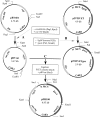Identification of Lactobacillus sakei genes induced during meat fermentation and their role in survival and growth
- PMID: 17308175
- PMCID: PMC1855608
- DOI: 10.1128/AEM.02396-06
Identification of Lactobacillus sakei genes induced during meat fermentation and their role in survival and growth
Abstract
Lactobacillus sakei is a lactic acid bacterium that is ubiquitous in the food environment and is one of the most important constituents of commercial meat starter cultures. In this study, in vivo expression technology (IVET) was applied to investigate gene expression of L. sakei 23K during meat fermentation. The IVET vector used (pEH100) contained promoterless and transcriptionally fused reporter genes mediating beta-glucuronidase activity and erythromycin resistance. A genomic library of L. sakei 23K was established, and the clones were subjected to fermentation in a raw-sausage model. Fifteen in carne-induced fusions were identified. Several genes encoded proteins which are likely to contribute to stress-related functions. One of these genes was involved in acquisition of ammonia from amino acids, and the remaining either were part of functionally unrelated pathways or encoded hypothetical proteins. The construction and use of isogenic mutants in the sausage model suggested that four genes have an impact on the performance of L. sakei during raw-sausage fermentation. Inactivation of the heat shock regulator gene ctsR resulted in increased growth, whereas knockout of the genes asnA2, LSA1065, and LSA1194 resulted in attenuated performance compared to the wild-type strain. The results of our study are the first to provide an insight into the transcriptional response of L. sakei when growing in the meat environment. In addition, this study establishes a molecular basis which allows investigation of bacterial properties that are likely to contribute to the ecological performance of the organism and to influence the final outcome of sausage fermentation.
Figures




Similar articles
-
Comparative genomics of Lactobacillus sakei with emphasis on strains from meat.Mol Genet Genomics. 2011 Apr;285(4):297-311. doi: 10.1007/s00438-011-0608-1. Epub 2011 Mar 3. Mol Genet Genomics. 2011. PMID: 21369871
-
Assertiveness of Lactobacillus sakei and Lactobacillus curvatus in a fermented sausage model.Int J Food Microbiol. 2018 Nov 20;285:188-197. doi: 10.1016/j.ijfoodmicro.2018.04.030. Epub 2018 Apr 20. Int J Food Microbiol. 2018. PMID: 29728282
-
Catabolism of N-acetylneuraminic acid, a fitness function of the food-borne lactic acid bacterium Lactobacillus sakei, involves two newly characterized proteins.Appl Environ Microbiol. 2013 Mar;79(6):2012-8. doi: 10.1128/AEM.03301-12. Epub 2013 Jan 18. Appl Environ Microbiol. 2013. PMID: 23335758 Free PMC article.
-
Lactobacillus sakei: A Starter for Sausage Fermentation, a Protective Culture for Meat Products.Microorganisms. 2017 Sep 6;5(3):56. doi: 10.3390/microorganisms5030056. Microorganisms. 2017. PMID: 28878171 Free PMC article. Review.
-
Functional meat starter cultures for improved sausage fermentation.Int J Food Microbiol. 2006 Feb 15;106(3):270-85. doi: 10.1016/j.ijfoodmicro.2005.06.027. Epub 2005 Oct 5. Int J Food Microbiol. 2006. PMID: 16213053 Review.
Cited by
-
CtsR, the Master Regulator of Stress-Response in Oenococcus oeni, Is a Heat Sensor Interacting With ClpL1.Front Microbiol. 2018 Dec 18;9:3135. doi: 10.3389/fmicb.2018.03135. eCollection 2018. Front Microbiol. 2018. PMID: 30619203 Free PMC article.
-
Development and optimization of a fluorescent differential display PCR system for analyzing the stress response in Lactobacillus sakei strains.Nutrients. 2009 Feb;1(2):210-23. doi: 10.3390/nu1020210. Epub 2009 Nov 30. Nutrients. 2009. PMID: 22253979 Free PMC article.
-
Utilization of Host-Derived Glycans by Intestinal Lactobacillus and Bifidobacterium Species.Front Microbiol. 2018 Aug 17;9:1917. doi: 10.3389/fmicb.2018.01917. eCollection 2018. Front Microbiol. 2018. PMID: 30177920 Free PMC article. Review.
-
Improvement of raw sausage fermentation by stress-conditioning of the starter organism Lactobacillus sakei.Curr Microbiol. 2008 Nov;57(5):490-6. doi: 10.1007/s00284-008-9274-x. Epub 2008 Sep 27. Curr Microbiol. 2008. PMID: 18820967
-
Stress Physiology of Lactic Acid Bacteria.Microbiol Mol Biol Rev. 2016 Jul 27;80(3):837-90. doi: 10.1128/MMBR.00076-15. Print 2016 Sep. Microbiol Mol Biol Rev. 2016. PMID: 27466284 Free PMC article. Review.
References
-
- Axelsson, L., and S. Ahrné. 2000. Lactic acid bacteria, p. 365-386. In F. G. Priest and M. Goodfellow (ed.), Applied microbial systematics. Kluwer Academic Publishers, Dordrecht, The Netherlands.
MeSH terms
Substances
LinkOut - more resources
Full Text Sources

